11 Self-Healing Techniques to Heal Your Heart and Soul

Maybe it’s a past hurt that still stings, a fear of the future that clouds your present, or a simple feeling of being lost and out of balance. These experiences are woven into the fabric of life and we are bound to experience them at some point.
Such experiences can often play an important role in our growth as a person but at times, they can also leave us feeling broken, bruised, and simply out of sync.
Self-healing isn’t about erasing the past or becoming a perfect person. It’s a journey of gentle understanding and moving in the direction of internal progress. It’s an opportunity to listen to your inner voice and nurture your well-being.
See yourself as a beautiful garden. It’s a place of beauty and growth, but even the most vibrant gardens experience the challenges and harshness of weather.
Sometimes, storms might come and damage the flowers, or weeds may take root. Self-healing is nurturing the garden back to health by providing it with the sunlight, water, and care it needs to blossom again.
You wouldn’t expect a wilting plant to bloom overnight, would you? It will take a bit of time as you create a nurturing space for yourself, where you can heal at your own pace and not only survive the storms but blossom even brighter than before.
What to Expect From This Guide…
This guide offers some tools and practices to help you on your self-healing journey. There’s no right or wrong way to do this. Experiment, find what resonates with you, and most importantly, be kind to yourself.
Always remember that everything you need to heal and become whole again is already within you. You just need to tap into it and that’s exactly what we’ll be looking into below.
Within you lies the strength to create a life filled with peace, joy, and the unshakeable sense that you are capable of overcoming anything.
Table of Contents:
- Feel Your Feels: Why Bottling Up Hurts More
- Reframing Your Story: Rewrite the Narrative of Your Past
- The Power of “No”: Setting Boundaries for Inner Peace
- Declutter Your Space, Declutter Your Mind: Creating a Sanctuary
- Journal Your Journey: Uncover Thoughts and Find Clarity
- Forgive Yourself (and Others): Letting Go for Freedom
- Cultivating Gratitude: Shifting How You Experience Life
- Inject Mindfulness in Your Everyday Life
- Move Your Body, Heal Your Mind: The Mind-Body Connection
- Small Steps, Big Impact: Building Sustainable Habits
- Connect and Belong: Nurture Relationships for Support and Growth
- A Life Beyond the Pain, Hurt, and Suffering…
1. Feel Your Feels: Why Bottling Up Hurts More
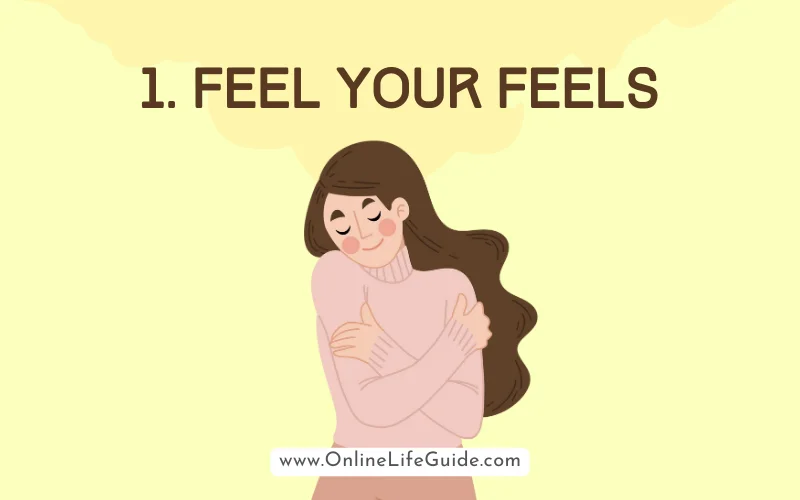
We often suppress our emotions because we don’t want to appear vulnerable. Or we block those emotions because we don’t want to deal with them and feel overwhelmed.
We might tell ourselves, “I shouldn’t feel this way,” or “Just get over it.” However, bottling up feelings can manifest as physical tension, anxiety, and even illness.
Our emotions are messengers, carrying important information about our needs and desires. Ignoring them can lead to emotional dysregulation and hinder our ability to cope with life’s challenges.
This leads us to more pain in the long run.
Learning to Feel Your Feels:
- Acknowledge your emotions: Notice what you’re feeling, whether it’s sadness, anger, joy, or fear. Give it a name. There are no “bad” emotions. All emotions are valid.
- Allow yourself to feel fully: Don’t judge yourself for your emotions. Cry if you need to, scream into a pillow, or express yourself creatively through painting, writing, or some other craft.
- Practice healthy release: Find ways to release pent-up emotions in a healthy way. Talk to a trusted friend or therapist, exercise, spend time in nature, and engage in activities that bring you joy.
By embracing your emotions and allowing yourself to feel them fully, you’ll gain a deeper understanding of yourself and the flow of your thoughts and emotions, and that is the first essential step toward healing.
2. Reframing Your Story: Rewrite the Narrative of Your Past
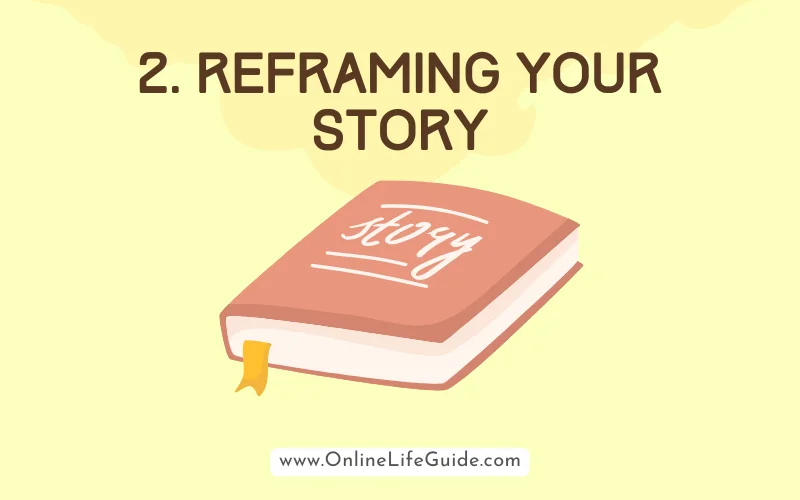
Our past experiences shape our perspective. But sometimes, we cling to negative narratives about ourselves or past events. These narratives come in many forms:
- “I’m not good enough.”
- “People don’t respect me.”
- “I always attract toxic people.”
- “I’ll always fail.”
Reframing your past involves challenging these limiting beliefs and rewriting the story.
Shifting Your Perspective:
- Ask empowering questions: Instead of dwelling on “what ifs” and “why me” ask questions that empower you. For example, “What can I learn from this experience?” “How has it made me stronger?”
- Focus on growth: Look for the positive aspects of your past experiences. Even difficult events can teach us valuable lessons and wisdom.
- Forgive and accept: Holding onto resentment towards yourself or others hinders healing. Forgive yourself for past mistakes and accept what you cannot change.
As you reframe your past with a more positive lens, you rewrite the narrative of your life and step into a future filled with possibility.
3. The Power of “No”: Setting Boundaries for Inner Peace
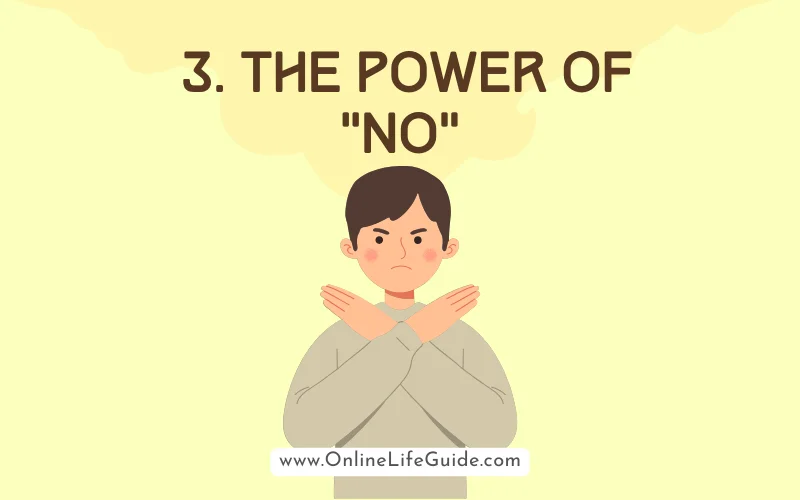
Setting boundaries is crucial for self-respect and emotional well-being. It allows you to create a safe space for yourself and protect your energy.
However, saying “no” can be difficult, especially when we want to please others or avoid conflict.
Learning to Say “No” with Confidence:
- Identify your limits: Be clear about your needs and limitations. What drains your energy? What compromises your values? Knowing your boundaries empowers you to say “no” with confidence.
- Practice assertive communication: Communicate your boundaries clearly and directly. You don’t need to apologize for saying “no.” A simple, “Thank you for the invitation, but I’m unable to attend,” is sufficient.
- Anticipate pushback: Be prepared for some people to resist your boundaries. Remember, it’s okay to prioritize your well-being.
Setting boundaries is an act of self-love. It allows you to create a less stressful life and fosters healthier relationships built on respect and understanding.
If you struggle with saying No to people, I have a full in-depth on How to Say NO. Check it out!
4. Declutter Your Space: Building a Sanctuary
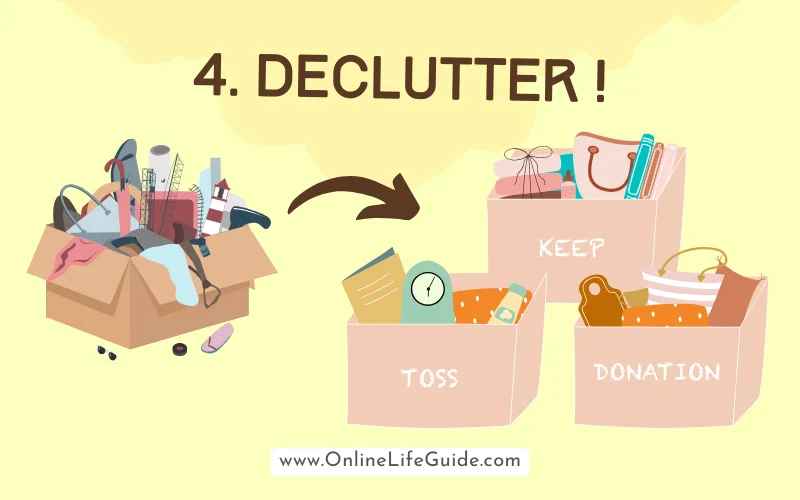
Our physical environment has a profound impact on our mental well-being. Clutter can create a sense of overwhelm and contribute to anxiety and depression greatly.
Taking the time to declutter your living space can be a powerful act of self-care. When you organize and clean up, you’re not just decluttering your surroundings, you’re essentially decluttering your mind.
Transforming Your Space:
- Start small: Don’t feel overwhelmed by the idea of a complete overhaul. Begin by tackling one drawer, shelf, or room at a time.
- Focus on functionality: Let go of items that no longer serve a purpose or bring you joy. Donate, sell, or recycle what you don’t need.
- Create a calming environment: Once decluttered, personalize your space with items that inspire you and bring you peace. This could include calming colors, natural elements, or artwork that resonates with you.
As you declutter your physical space, you’ll find a sense of clarity and peace seeping into your mind. A calm and organized environment promotes focus, reduces stress, and creates a sense of well-being.
5. Journal Your Journey: Uncover Thoughts and Find Clarity
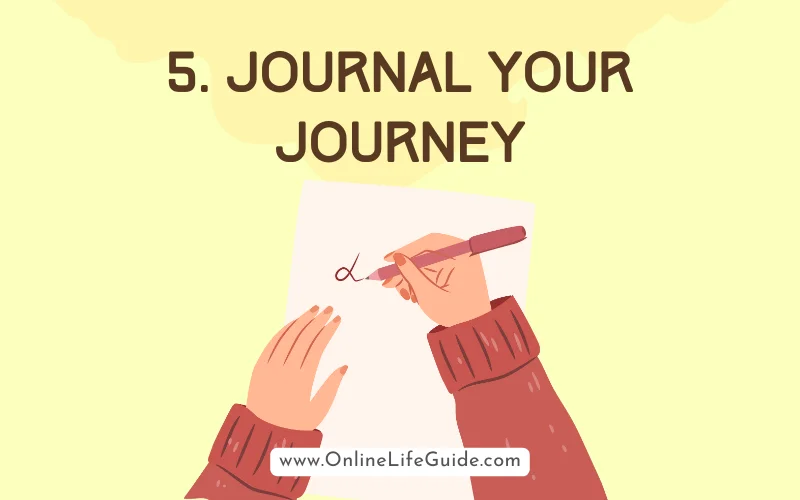
Journaling is a powerful tool for self-discovery and emotional processing. It provides a safe space to express your thoughts and feelings without judgment.
Many people find it helpful to write daily, while others may choose to journal when they’re feeling particularly overwhelmed or confused.
Some tips for Journaling:
- Free-flowing thoughts: Don’t worry about grammar or spelling. Simply write whatever comes to mind. This “stream-of-consciousness” approach can reveal hidden patterns and limiting beliefs.
- Ask yourself questions: Use journaling as an opportunity for self-reflection. Ask yourself questions like, “What am I grateful for today?” “What challenges am I facing?” or “What do I truly desire?”
- Track your progress: Use your journal to monitor your emotional journey. Over time, you’ll be able to identify triggers, celebrate milestones, and witness your own growth.
Journaling is a personal practice, so find what works best for you. Whether it’s handwritten entries, voice recordings, or digital journaling apps, the key is to be consistent and allow yourself the freedom to express yourself authentically.
Through journaling, you’ll gain valuable insights, release pent-up emotions, and find clarity on your path to self-healing.
Some journaling prompts to get you started:
- What am I grateful for today?
- What challenges am I currently facing?
- What emotions am I experiencing, and what might be causing them?
6. Forgive Yourself (and Others): Letting Go for Freedom
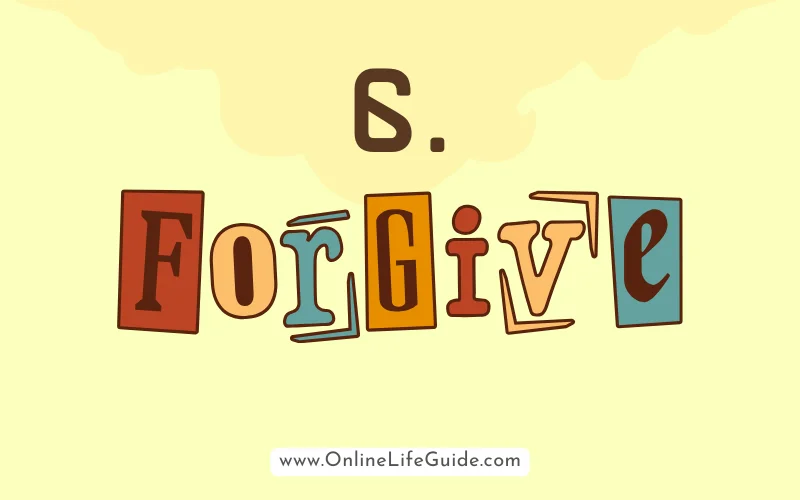
Holding onto resentment towards yourself or others hinders healing. Resentment is like carrying a heavy backpack – it weighs you down and prevents you from moving forward.
Forgiveness, on the other hand, is not about condoning and approving someone else’s actions. It’s about releasing the burden of anger and bitterness for your own peace of mind.
It’s about releasing negativity and choosing peace for yourself.
Start seeing forgiveness as a gift you give yourself, not the other person.
The Path to Forgiveness:
- Practice self-compassion: We all make mistakes. Forgive yourself for past missteps and extend kindness to yourself as you would a friend.
- Understand that everyone makes mistakes: Shift your perspective and recognize that people are complex. They may have acted out of hurt or ignorance.
- Let go of blame: Clinging to blame keeps you stuck in the past. Release the need to assign fault and focus on your own healing journey.
- Acknowledge your hurt: Allow yourself to feel your emotions before you can move on.
- Shift your perspective: Try to understand the situation from a different angle. Was it a misunderstanding?
- Let go of negativity: Wish the person well and release the emotional burden.
Forgiveness is a process, not a one-time event. Be patient with yourself as you process your emotions and start letting go.
As you learn to forgive, you’ll experience a lightness of being and a renewed sense of freedom.
7. Cultivating Gratitude: Shifting How You Experience Life
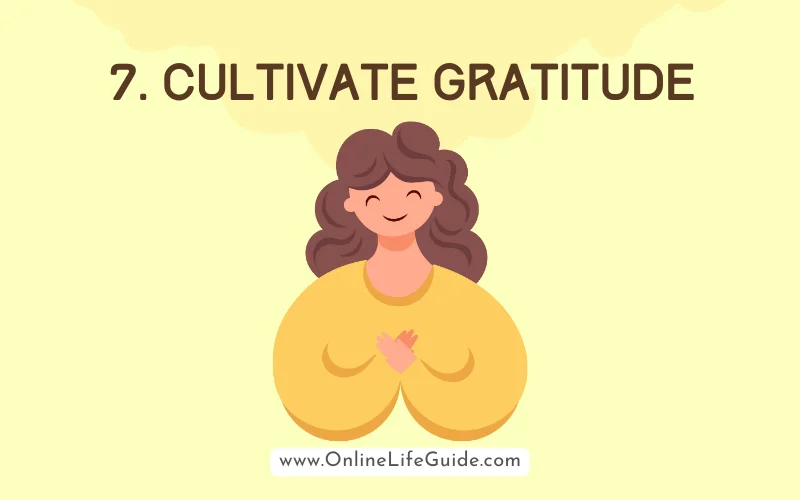
Gratitude rewires your brain to focus on the positive. Studies show that practicing gratitude can boost happiness, reduce stress, and improve overall well-being. By acknowledging the good things in your life, you cultivate a sense of abundance and appreciation.
Growing Your Gratitude Garden:
- Start a gratitude practice: Dedicate a few minutes each day to reflect on the things you’re grateful for. This could be anything from a supportive friend to a delicious meal to the beauty of nature.
- Keep a gratitude journal: Write down three things you’re grateful for each day. Over time, you’ll build a treasure trove of positive experiences to revisit when you need a boost.
- Shift your focus: When negative thoughts arise, consciously choose to redirect your attention to something you appreciate. This simple act will break the negative pattern and replace it with a more optimistic and broader perspective.
Gratitude is a powerful tool for cultivating happiness and inner peace. As you incorporate gratitude practices into your daily life, you’ll nurture a sense of abundance and attract more positive experiences into your world.
8. Inject Mindfulness into Your Everyday Life!
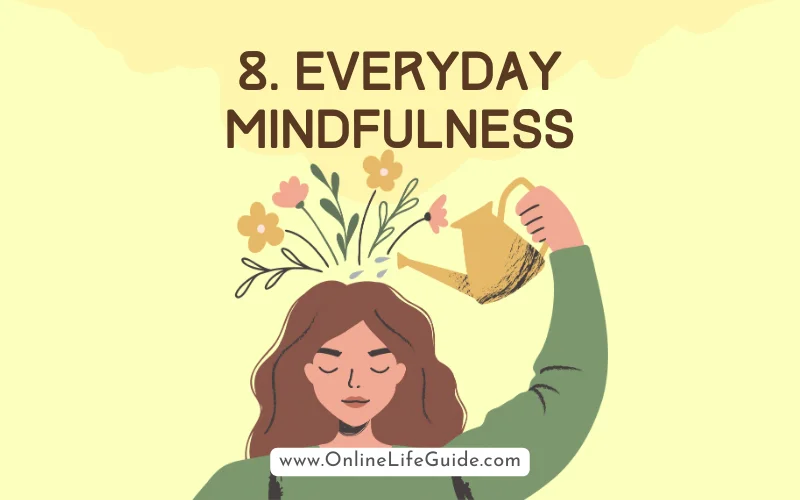
Mindfulness is the practice of paying attention to the present moment without judgment. It allows you to become more aware of your thoughts, feelings, and bodily sensations.
In our fast-paced world, we often operate on autopilot, missing the richness of the present moment. Mindfulness helps us slow down, appreciate the little things, and cultivate a sense of calm amidst the chaos.
Bringing Mindfulness into Your Day:
- Mindful breathing: Take a few minutes each day to focus on your breath. Notice the rise and fall of your chest and the sensation of air entering and leaving your nostrils. Simple breathing exercises can anchor you in the present moment and reduce stress.
- Mindful movement: Whether it’s during exercise, walking, or even everyday activities like washing dishes, focus on your body’s sensations. Notice the movement of your limbs, the feeling of your feet on the ground, and the engagement of your muscles.
- Mindful eating: Slow down during meals. Savor the taste, texture, and aroma of your food. Put away distractions like your phone and truly connect with the experience of nourishing your body.
Mindfulness is developed with practice. There will be days when your mind wanders. Be kind to yourself and gently bring your attention back to the present moment.
With consistent effort, mindfulness can become a powerful tool for managing stress and anxiety, healing your mental and emotional self, and fostering inner peace.
9. Move Your Body, Heal Your Mind: The Mind-Body Connection
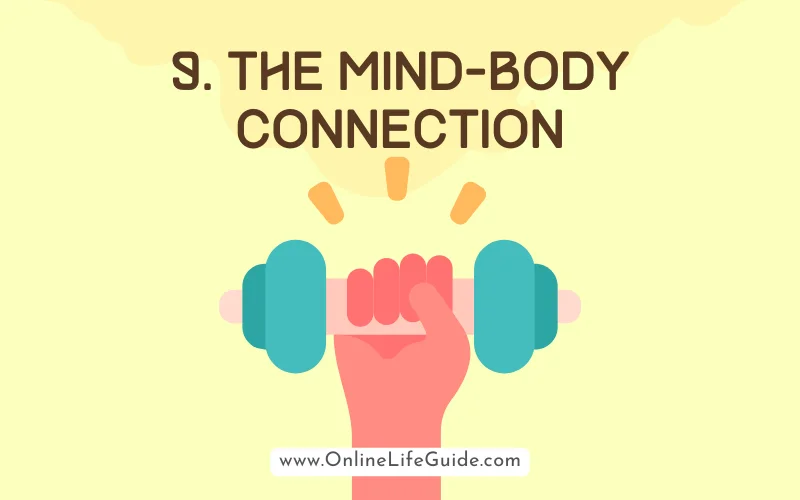
There’s a well-established link between physical activity and emotional well-being. Exercise releases endorphins, natural mood enhancers that elevate your mood and reduce stress hormones.
Even small bursts of movement can significantly improve your mental state.
Finding Movement You Enjoy:
- Discover your passion: Experiment with different activities until you find something you truly enjoy. This could be anything from sports to swimming, hiking to yoga. When you find exercise you love, you’re more likely to stick with it.
- Start small and build gradually: Don’t feel pressured to jump into an intense workout routine. Begin with small, achievable goals and gradually increase the duration and intensity as your fitness improves.
- Move your body every day: Find ways to incorporate movement into your daily routine. Take the stairs instead of the elevator, go for a brisk walk during your lunch break, or do some stretching and a few jumping jacks while watching TV.
Moving your body is a powerful tool for self-healing. Regular exercise not only improves your physical health but also boosts your mood, reduces stress, and enhances your overall well-being.
10. Small Steps, Big Impact: Building Sustainable Habits
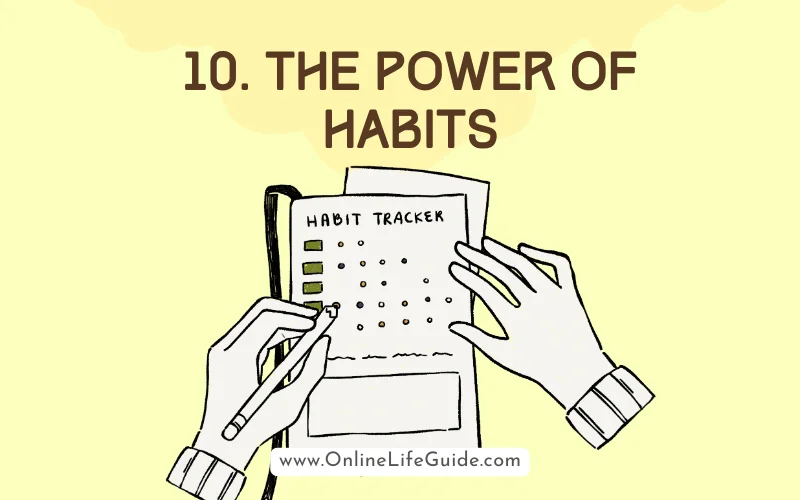
The journey to self-healing might not always be linear. There will be setbacks and moments of doubt.
The key is to focus on progress, not perfection.
Building sustainable habits is far more effective than drastic changes that you’re unlikely to maintain in the long run.
Making Lasting Changes:
- Set SMART goals: Make your goals Specific, Measurable, Achievable, Relevant, and Time-bound. Instead of “get healthy,” aim for “walk for 30 minutes three times a week.”
- Celebrate small wins: Acknowledge and appreciate your progress, no matter how small. This will keep you motivated and focused on your long-term goals.
- Be kind to yourself: We all make mistakes. If you fall into a self-sabotaging pattern or lose consistency with your healing habits, don’t beat yourself up. Just get back on track with your next healthy choice.
Remember, the process of mental and emotional healing is a marathon, not a sprint. By focusing on small, sustainable habits, you’ll create lasting changes that contribute to your overall well-being.
11. Connect and Belong: Nurture Relationships for Support and Growth
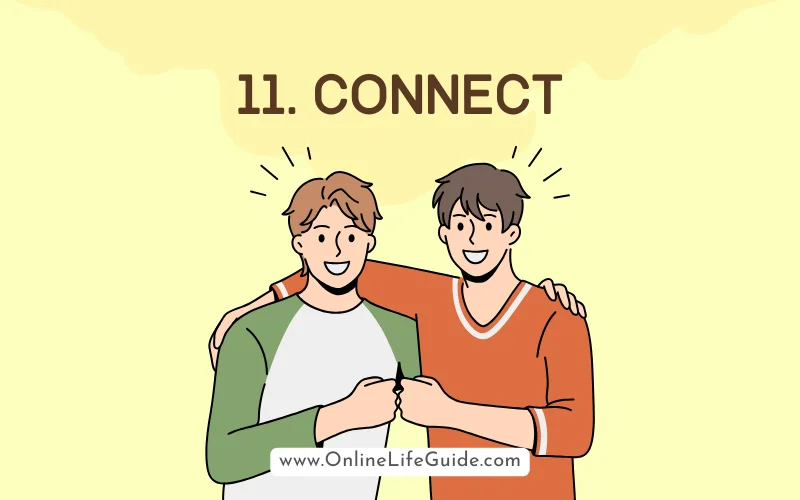
Humans are social creatures who thrive in connection. Strong social connections provide a sense of belonging, support, and love.
These connections can be with family, friends, romantic partners, or even a supportive online community.
Building Strong Relationships:
- Invest in quality time: Make time for the people who matter most. Put away distractions and be fully present during your interactions.
- Practice active listening: Show genuine interest in others and listen without judgment.
- Offer support: Be there for your loved ones during challenging times. Offer a listening ear, a helping hand, or simply your presence.
You might be wondering why I am suggesting “offering” support and being the one to provide a listening ear, instead of you seeking support.
Yes, you can and should seek direct support when needed.
However, the act of giving makes you step out of your pain and negative thoughts and switches gears in your heart and mind.
This is a tremendous opportunity to heal and let go of the past pains and hurt, as you gather new experiences by helping others.
A Life Beyond the Pain, Hurt, and Suffering
There will be days when shadows creep back in, and that’s okay. Acknowledge them, come back to this guide, and use the tools you’ve gathered here.
Use these Affirmations for Emotional Healing to instantly shift the direction of your thoughts and emotions.
Know that with each challenge you overcome, you emerge a little stronger, a little wiser, and a little closer to the vibrant, resilient version of you.
The tools and techniques offered here are just the beginning. Keep exploring resources, experiment with different practices, and find what works best for you.
Self-healing is a personal journey, so own it, personalize it, and make it your own unique masterpiece.
May you find solace in the quiet moments, courage in the challenges, and a blossoming spirit that continues to grow with each passing day.
And hey, I’d love to hear from you in the comments section below.
Take good care of yourself. Talk to you soon!









Thanks so much for this guide and I’ll be saving it to have just in case I have to come back to it.
My pleasure! Happy to serve 🙂